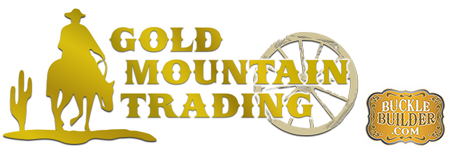 $100 min purchase Continental U.S. only
$100 min purchase Continental U.S. only 
Steve Miller, Sculptor
I
often lament I was born too late to
have lived in the west of legend as we raemember and celebrate it today. Like
many of you, my heart has always been a part of those wild, dangerous, romantic,
and sometimes simpler times. My love of art and all things cowboy, have been my
life. I’m an active team roper, and spend most of my spare time either on my horse
or sculpting, drawing, or just mindlessly doodling on everything, often to the
chagrin of my wife. I am extremely blessed that my position here at Montana Silversmiths
[Vice President] allows me to do both, while contributing to the western industry
that I love.
The west, to me, is not about a direction or place; it is about a life, a lifestyle,
a culture, a romance. You can be part of the west even if you live in the east.
That is its beauty. Today, it’s an almost mystic place of Indians and cowboys,
lawmen and ladies, villains and soiled doves. Yet, it’s real and it’s alive in
all of us who love the west. That connection is the inspiration for each piece
in my western sculpture series.
I have tried to tell a story about a short time in America’s history that has
become the indelible identity of America the world over.
My art concentrates primarily on the people and times of the mid- to late 1800’s.
It’s how I see the west. But the west as we know it started with the discovery
of the New World. The first Europeans entered a new land, a land that to them
seemed an empty wilderness to be settled and tamed. They moved westward in ever
increasing numbers to claim the land and its bounties, and to put down roots.
These people were the seeds of our nation. The setting for the American west came
from all parts of the world drawn by this new land.
But the land they saw as empty wilderness was not empty, and it certainly would
not tame easily. This land was home to many tribes, languages, and cultures of
people. These were an innocent and primitive people, open, and even helpful to
the culture that would soon overwhelm them. These were a people who did not work
iron, copper, or steel, nor did they know of the wheel, or write their language.
But they did know the land and how to live off its bounty. It provided all they
needed, and they left it as they found it, unscarred and flourishing with animal
life of every kind. The meeting of these two cultures would soon become a violent
collision.
This inevitable clash was complicated by the absolute inability of the Native
Americans to comprehend the great growing industrial culture grinding relentlessly
westward, or understand how great the rift that existed between the two cultures.
I symbolize this by the railroad that was moving steadily and unmercifully across
America from East to West, in “Of Stone and
Steel”.
With the rails came easier access to the west, and increasing tensions. The great
buffalo herds were nearly extinguished, and centuries of skirmishing, inevitably
erupted into bloody all out war for the land. The Indian people were caught in
a cruel paradox, opposing the incursion of the white man’s culture, and at the
same time realizing the need for the white man’s tools, weapons, and trade goods.
I symbolize this struggle in a piece of incredible horsemanship that so defined
these warriors, and the undeniable need for new technology. I call it, “His
New Winchester”.
As the Indian Wars ground to a close, and the great bison herds passed into history,
the west was again seen as a land of wide open spaces, endless azure skies and
grass so high it touched the belly of a good horse. Grass that stretched the horizons
like a green ocean tossed by a constant nagging wind. Country that could make
a man rich, or kill him, made no difference to the land. Grasslands that inspired
the great cattle drives of the late 1800’s. Cattle markets brought cowboys and
cattle barons. New opportunity brought the frontier towns, and progress, outlaws,
lawmen, and waves of new settlers. Perhaps this is the most colorful, remembered,
and relived time in our history.
I have tried to capture moments that, in reality, were rare, but that came to
personify the West. A cowboy, bound by his honor, trying to turn a stampede, and
paying “The
Highest Price for Beef”, mundane work turned exciting in “When
Beef Was Wild”, and the thrill of putting their life on the line just for
fun, as could happen, “When
Cowboys Take a Dare”, the lost art of the “The
Houlihan”, or the perils of fording a rain swollen river as was necessary
each time the herd reached “The Crossing”.
I want to finish my first offering with a salute and thanks to some of the strongest,
bravest, humans ever to set foot in the west, its women. We would not be here,
if there had not been women with the courage and strength to leave all they knew
and move out across, what to them at the time, was a vast and unknown wilderness.
These were the wives, mothers and daughters who really “tamed” the west. I call
these first two sculptures, “When
a Woman Knew Her Place”, and “Sittin’
Pretty”.
This will be the first series of what I hope, with your support, is just the beginning.
I hope you will collect at least some of each of the elements of this work, as
together they tell a wonderful story. It is my story. And, I hope, your story
of the west.
